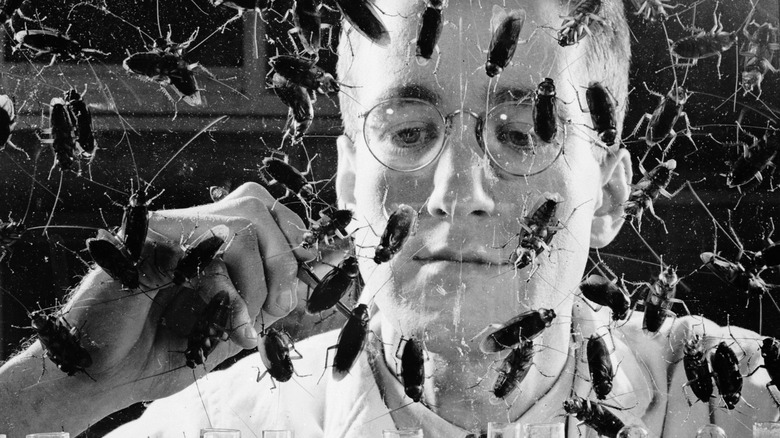You Might Be Eating Cockroaches Without Knowing It
Among all the creepy-crawly creatures in the world, cockroaches are the creepy crawliest, according to many. These hearty insects live on nearly every continent and tend to build their homes in all sorts of nooks and crannies — and, in the view of the cockroach, the dirtier and more unappealing that place is, the better (via the BBC). In some parts of the world, though, cockroaches are on the menu, although that buggy diet has yet to catch on everywhere, as U.S. News & World Report notes. Even though roaches may yet to be served at a restaurant near you, far more people eat bits and pieces of insects — including cockroaches — than they realize, and the U.S. Government says it's okay.
This makes some sense because insects are among the most plentiful and industrious living things on the planet, with nearly a million species so far identified, according to the World Atlas. What's more, new orders of insects are discovered consistently, even today, as Scientific American goes on to report. Given the ubiquity of insects in every climate — and especially in and around our agricultural operations where food is grown and where what we eat gets processed and packaged — is it really reasonable to expect that no insect parts at all will make it into our food supply? Not according to the FDA's Food Defect Levels Handbook.
Cockroach phobias are common
Finding the notion of eating a cockroach revolting, among a number of other insect types, is nothing new, as the BBC goes on to report. (Nor are insect phobias, for that matter; fear of cockroaches is called katsaridaphobia, per Psych Times.) Even early American colonist John Smith of the Jamestown settlement noted the foul-smelling excrement of the "cacarooch." There are often good reasons insects should be avoided, such as mosquitoes, which not only leave painful and itchy welts when they bite us but are also known carriers of deadly diseases. Overall, though, cockroaches themselves are mostly just victims of bad publicity.
Sure, roaches like to eat garbage and are known to inhabit icky environments, and disease can be transmitted through roach feces and vomit or through bacteria living in their gut. But should you happen to bite down on one or even just a bit of one — especially roaches bred in captivity with a clean food supply — chances are there will be few ill effects and, at worst, a bad case of food poisoning. That's exactly what the U.S. Food and Drug Administration counted on when that regulatory agency set its standards for how many insect parts the typical food producer can allow into our food supply, based on reporting from Green Queen.
Our food has far more insect parts in it than you may realize
In setting its regulatory standards, the U.S. FDA's Food Defect Levels Handbook differentiates between unnatural contaminates — such as chemicals and pesticides, and natural contaminants like dust, dirt, and, yes, you guessed it, insects — and how much of each type is safe for humans to eat. Given how common natural contaminants are and how difficult it really would be for food producers and processors to keep our food supply completely free from them, far more natural contaminants are allowed in our food than pesticides. For this reason, we all likely eat bits of insects that have hitched a ride on the food along the way.
That might includes aphids in broccoli or fly eggs in our berries, among many other examples, according to a study from Terro, a leading pest control company. When it comes to a favorite treat for many, though, chocolate, there's an average of eight insect parts allowed in each piece, and big chocolate eaters could consume thousands of bug bits each year, based on reporting from Green Queen. Pasta is allowed a few hundred insect bits per every few hundred grams of pasta before it gets taken from market shelves, per the FDA. As insect consumption, whether intentional or otherwise, increases all over the world, it's also notable that what might at first be considered a food allergy — such as to chocolate — could be an insect allergy instead, per the Allergen Bureau.


